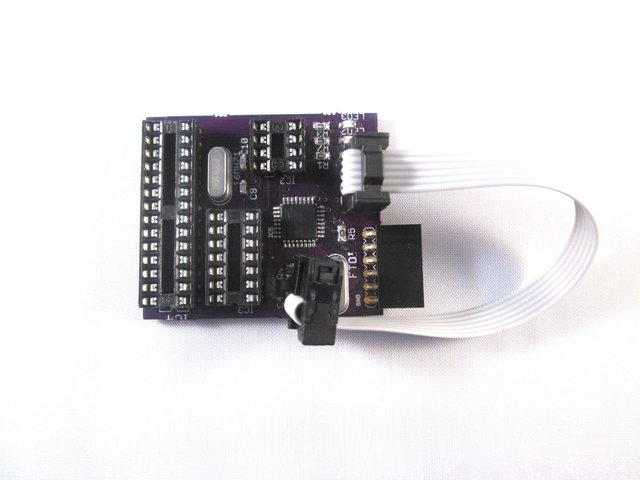FTDI Programmer
This is a programmer board for use with a FTDI adaptor. This board connects to a computer via a FTDI/USB adaptor.
See version 1 documentation here

Technical Specifications
Currently known supported Micro Controller Units:
Attiny85
Attiny45
Attiny13
Attiny84
Atmega328
Atmega168
Atmega8
Operates on 5Volts.
3 Status leds
1x FTDI Port
1x SPI port
Firmware
The firmware used by the programmer is the sketch provided by the Arduino Example sketch ArduinoISP. See File | Examples | ArduinoISP.
Usage
Connect the hardware
Insert the MCU to program on the programmer board. Beware of the direction when the inserting the MCU. The small dot must be pointed toward the left of the board (opposite the leds).
Connect the Programmer board to the FTDI adaptor. Both grounds must be connected together.
Connect the FTDI adaptor to the computer with a USB cable.
Make sure the FTDI adaptor is set to operate on 5V.
Once all connected the Programmer board will show heartbeat with the green led.
Initial Setup
For anything below make sure Arduino as ISP is selected in Tools | Programmer menu.
Upload Bootloader
If programming an arduino MCU for the first time you must burn the bootloader onto it. For this first select the appropriate board in the Arduino IDE. Tools | Board . For example ATtiny85 @ 8Mhz or Arduino UNO. Then select Tools | Burn Bootloarder.
Upload Sketch (ATtiny)
Open your sketch file with the Arduino IDE. Make sure you select the appropriate MCU type in Tools | Board. Upload the sketch from the IDE.
How to program an Attiny85 or Attiny84
Upload Sketch (ATmega)
Open your sketch file with the Arduino IDE. Make sure you select the Arduino UNO type in Tools | Board. Upload the sketch from the IDE using the Upload Using Programmer function found under the File menu.
Warning. Do not use the normal Upload function of the IDE as it will overwrite the main mcu sketch. This can be recovered by re-uploading the ArduinoISP sketch.
Overwritten sketch
The primary ATmega328 sketch could be inadvertently overwritten. This is an easy fix. You can recover its initial state by uploading the original sketch. To do so remove all secondary chips. In the Arduino IDE select File | Examples | ArduinoISP. Then make sure Tools | Board | Arduino UNO is selected. Then upload that sketch.

